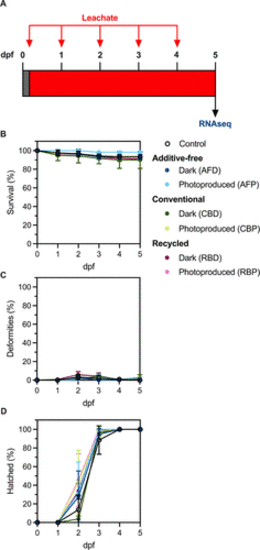- Title
-
Formulation Controls the Potential Neuromuscular Toxicity of Polyethylene Photoproducts in Developing Zebrafish
- Authors
- James, B.D., Karchner, S.I., Walsh, A.N., Aluru, N., Franks, D.G., Sullivan, K.R., Reddy, C.M., Ward, C.P., Hahn, M.E.
- Source
- Full text @ Env. Sci. Tech.
|
Experimental timeline (A). Zebrafish embryos were exposed to leachates daily from 4 hpf to 5 dpf and monitored for developmental endpoints. At 5 dpf, zebrafish larvae were collected for measurement of gene expression by RNAseq. Survival (B), the prevalence of developmental deformities (e.g., edema, spinal curvature) (C), and hatching (D) during the semi-static developmental bioassay. Deformities were predominantly pericardial edema. The data presented are the mean ± standard deviation for n = 4 biological replicates of 30 embryos each. There was a statistical difference in survival at 4 and 5 dpf between the control and additive-free photoproduced leachate treatment as determined by a two-way repeated measures ANOVA with a Dunnett multiple comparisons test. The additive-free photoproduced leachate treatment had greater survival than the untreated control. There was no statistical difference in the prevalence of developmental deformities at any time between the control and any leachate treatment as determined by a two-way repeated measures ANOVA with a Dunnett multiple comparisons test. There was no statistical difference in hatching at any time between the control and any leachate treatment as determined by a two-way repeated measures ANOVA with a Dunnett multiple comparisons test. Data presented in panels (B–D) are included in Tables S2–S4. |

